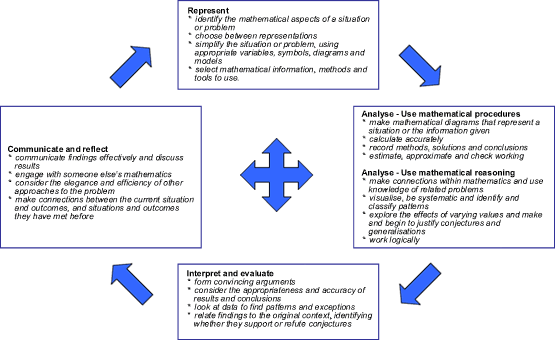Integrating rich tasks - activity 1.4
To go back to the introduction to this series of professional development activities, click here
How do higher-order thinking skills (HOTS) relate to rich tasks and problem solving?
This task aims to identify how rich tasks and problem solving fit together.
You will need the following resources:
Bloom taxonomy descriptor cards: Bloom-descriptors.doc
Problem-solving cycle cards: ProblemSolvingCycleCards.doc
Rich task cards: RichTaskCards.doc
Higher-order thinking skills are not about mathematical
content knowledge. Just like it is possible to engage in very hard
questions that involve a high level of content knowledge but few
problem-solving skills, it is also possible to identify very
difficult problems that only need very low levels of mathematical
content knowledge. In the former case, you are going to need
well-tuned knowledge skills and in the latter, your HOTS.
What is a problem?
A problem is something you do not immediately know how to
solve. There is a gap between where you are and even getting
started on a path to a solution. This means that something that is
a problem to your students is something that they cannot get to
grips with immediately and requires thinking and playing time. By
playing with the mathematics, patterns and connections often reveal
themselves. We need to arm our pupils with a repertoire of skills
to help them step into problems independently rather than
immediately turning to us as teachers to ask what to do! We can
begin by selecting problems with engaging starting points which
invite pupils to step in (such as a game). Once they get started,
the richness comes from what happens next. Ideas begin to emerge
from playing with the initial situation and sometimes from posing
problems of their own.
What is problem solving?
The need to apply problem-solving techniques to a problem is
an indicator that it has the potential to be a rich task. Problem
solving requires you to have a problem to solve, which may be one
you have been given or one you have posed for yourself. The
activity that we call 'problem solving' is a complex one and can be
considered as a cycle of activity (though the cycle often requires
us to move backward and forward whilst maintaining a general sense
of direction). There are many models of the problem solving cycle.
Possibly the most well known is the one described by Polya in his
book How to Solve It
(1957), which is a must-read for those of us interested in
improving our pupils' problem-solving skills. Here is one we use at
NRICH:
Image

(The Problem-Solving Cycle.doc is a larger version of the above which might be easier to read.)
The application
of the problem-solving cycle is a high-order skill. Evidence
suggests that few pupils utilise the problem-solving cycle
effectively. One important thing to note is the emphasis the cycle
places on the high-order thinking skills described by Bloom. It is
therefore not surprising that most pupils do not naturally have a
sense of where they are and what they might do next. One of our
aims when teaching mathematics is to help pupils become familiar
with this process and have confidence to use it.
See Polya, G.
(1957). How to Solve it, Princeton University Press.
How do rich tasks, the problem-solving cycle and higher-order thinking skills fit together?
Here is a task
to help answer this question.
Task
- Cut out the problem-solving cycle cards (ProblemSolvingCycleCards.doc ) and lay them out.
- Link them with the rich task description cards (RichTaskCards.doc ) and with the different aspects of Bloom's taxonomy (Bloom-descriptors.doc ).
We feel that any problem has the potential to be a rich task
but this depends on us as teachers offering those opportunities to
our pupils. We will talk about this in
Activity 2.1 .
